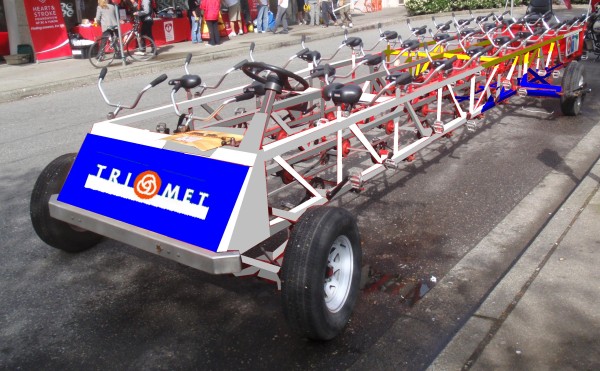For a long time, activists have frequently lumped public transit (including bus, Streetcar, and light rail) together in with various means of human-powered locomotion, including walking and bicycling. Today, TriMet and the Bicycle Transportation Alliance are proud to announce the HUMP-IT program. HUMP-IT, or Human Powered Intermodal Transportation, is intended to usher in a new age of Active Transit, in which commuters travel together using zero-emissions, human-powered vehicles.
A prototype vehicle, in TriMet livery, is shown below.
Unlike traditional busses, which are powered by fossil fuels such as diesel or CNG (compressed natural gas), or powered by electricity generated in various ways which are bad for the environment, HUMP-IT vehicles (being human powered) are true zero-emissions transit vehicles.
Riders of HUMP-IT vehicles will have two choices. Those who bring bicycles on board can simply mount their bikes into the HUMP-IT chassis, and then ride their bikes as they ride the bus. Those without bikes of their own can mount a fixed pedal station, and a mechanical power-transfer system will insure their physical inputs are transmitted to the wheels. BTA Executive Director Rob Sadowsky agreed, noting that many hard-core Portland cyclists have had an aversion to public transit. “With HUMP-IT, we’re hoping that even the skeptical members of our community will get on board”.
While the prototype vehicle shown above is uncovered, TriMet indicates that production vehicles will provide shelter from the elements.
According to Neil McFarlane, TriMet general manager, “with HUMP-IT, we are trying to solve a fundamental problem that bicycle commuters face when using public transit. Frequently, there is no room on board the bus or the train for a bicycle, and the bike lifts on our bus fleet frequently slow other travelers down. With HUMP-IT vehicles, attaching a bicycle to the bus chassis is trivial, with an ISO-standard mount.”
McFarlane also indicated that the zero-energy consumption of HUMP-IT vehicles would result in lower fares. “With HUMP-IT, we don’t have to pay for diesel or electricity, so of course we are going to pass the savings along to our riders”. However, advocates for OPAL were unimpressed, stating that it was inhumane and unfair for the poor to have to exercise for a lower fare. “We just want a fare that’s fair, so our constituents will fare better”, said an OPAL spokesman.
TriMet spokesperson Mary Fetsch stated that HUMP-IT vehicles may be deployed as early as Fiscal Year 2015. “We plan to put them on some of the shorter downtown routes, first. Those routes stop frequently, thus making the low top speed of HUMP-IT vehicles less of a problem. Plus, the frequent stops will give passengers a chance to rest. It wouldn’t be suitable to use HUMP-IT on express busses, partciularly the 94. Although that’s tempting…” When asked if she expected slow speed to be a problem, Fetsch responded, “Hey, it’s still faster than the Streetcar”.

10 responses to “HUMP-IT: TriMet and BTA introduce “Active Transit””
Too many stops at the burrito cart and HUMP will not be “zero emissions.”
But those emissions will occur regardless, so it is net-zero. :)
In related news, frequent PT contributor Michael Andersen has called for the sidewalks to be abolished, claiming that segregated facilities for pedestrians reduce safety (and treat them as second-class citizens); instead Andersen recommends that pedestrians “take the lane”.
For once I agree with Michael Anderson. Trains are taking the elevators in Chicago, and cars occasionally drive on the sidewalks. We need to abolish this false paradigm re: different modes of transportation need different infrastructure. Shared infrastructure would be cheaper.
Train taking an elevator.
Or, slightly more seriously:
Where to go to buy an elevator for real trains.
In other news, TriMet announces a new fare structure.
Dammit got me
OHSU announces on their Facebook page a proposed expansion to the Portland Aerial Tram.
In SF, someone has customized a Prius to run off of Muni’s trolleybus lines. :)